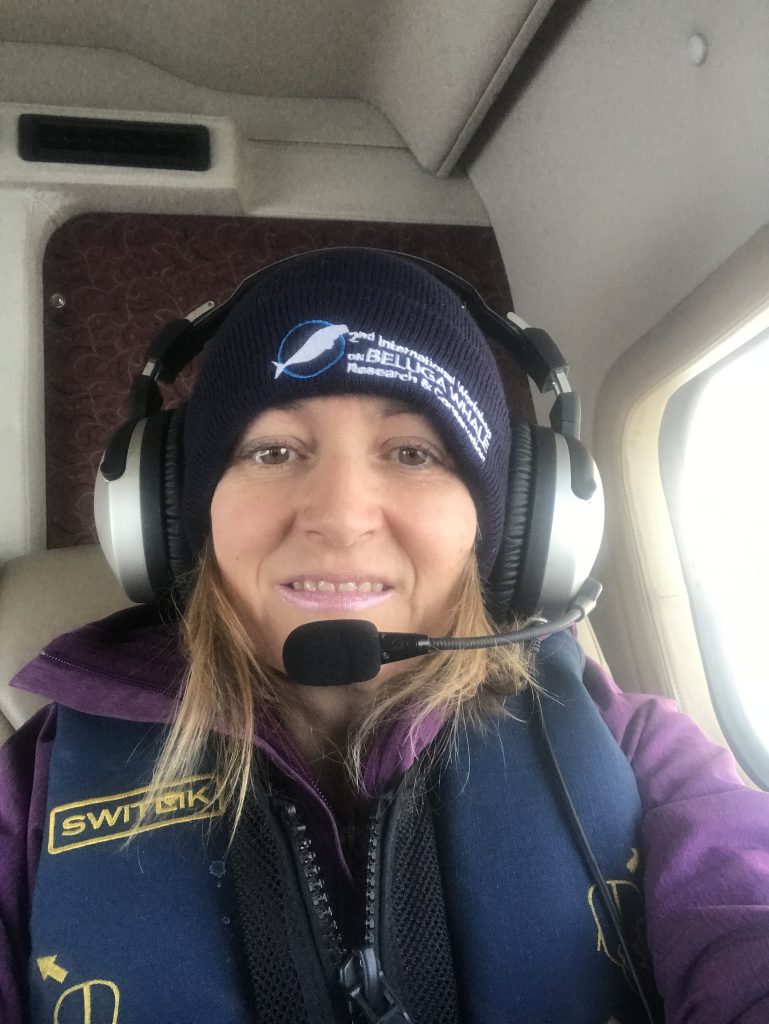Verena Gill moved to Alaska in 1989 after the Exxon Valdez oil spill so she could volunteer with the cleanup crews. That led to more volunteer work with the U.S. Fish and Wildlife Service, then graduate school, and eventually working as a wildlife biologist. She now works at NOAA where she oversees the recovery of threatened and endangered species in Alaska. Her previous position at NOAA was overseeing recovery of the Cook Inlet beluga whales.
Is there any particular species that you spend the most time on? Or one that worries you more than any other species?
Well, that would be two different answers. The one that worries me the most is the North Pacific right whale. Their number is probably in the 30s. That’s alarming, and we know very little about them. We don’t even know where they calve. We don’t exactly know their migration route. We don’t have an exact number. It’s pretty hard to study a population where it’s a needle in a haystack.
The one that we probably spend the most time on right now is the Cook Inlet beluga whale, because they’ve been identified as a Species in the Spotlight for NOAA. There are nine species across the nation that have a spotlight on them. This program brings them more attention and gets more resources to save these species that we consider at the highest risk of extinction.
Can you go a little bit more in depth on the status of the Cook Inlet beluga population?
Their 10-year trend from 2008 to 2018 has been a decline of 2.3 percent a year. So, they’re still declining. The last population estimate was around 279 animals. There is also a project called the photo ID project that is looking at photos of belugas. Everyone knows that you can take photos of humpback flukes and identify them, but I don’t know that so many people know you can take photos of belugas and identify them by the different marks and nicks.
They’re still listed under the Endangered Species Act. When you list a species under the Endangered Species Act, you come up with a recovery plan that has recovery actions. There are 64 for Cook Inlet belugas. I have a whole team of experts that come up with these actions and say we should do these actions to try and save this species. So, there’s a lot of work being done. There are a lot of partnerships being formed. There’s lots of citizen science work. The Species in the Spotlight has really brought people together.

You mentioned citizen science. What is the best thing for people to do to contribute?
I love citizen science. There’re just a few of us on staff and we can’t be out in the world, but there’re all these people who are excited to help. For Cook Inlet belugas, there are a couple of options. One that we’ve had going since 2019 is called the Alaska Beluga Monitoring Partnership. We have a website, akbmp.org. In the spring and in the fall every year, we have stations with trained volunteers who go out and monitor for belugas. You can sign up. You have to get trained, and we’ve been doing it virtually because of COVID. You just get trained, you go out with a lead volunteer for a while until you’re trained up, and then you can either help or lead sessions every single day.
It’s been interesting to collect data when the belugas come back to the Kenai River every year. [Citizen science is] filling in knowledge gaps. It turns out that belugas, for the last few years, at the end of August, beginning of September, will reliably come back within a few days of the same day. We wouldn’t have known that if we didn’t have citizen scientists out there.
What is there that gives you hope? Is there any animal in particular that you feel hopeful about or anything that keeps you buoyed?
I’ll tell you a story from this weekend. This is the kind of thing that gives me hope, little things. I have two daughters. One’s a freshman in high school and she was ski racing at Kincaid [in Anchorage]. And afterward there’s a Tasty Freeze that everybody goes to for ice cream and sodas and stuff. We were in there getting our curly fries and our ice cream. I’m standing there waiting cause it’s jam packed, and there’s this little girl, she’s probably about eight, and her brother, probably 11, and they’re there with their mom. The little girl was making a fuss about wanting a straw. “I want a straw!” And her brother was like, “You can’t have a straw, it’ll go up a turtle’s nose and kill it.” And mom’s like, “That’s right. We don’t have straws ‘cause we don’t wanna hurt the marine animals.”
That gave me great hope. It’s one little kid and one little straw, but it’s a whole movement. Everybody thinks we can regulate our way to recovery. We can’t regulate our way to recovery. We have to have public support. If you take a recovery action in isolation, it’s not gonna work because you need everybody on board. How do you get everybody on board? You get this ground sweep of support, and you get it by little kids not using straws. So that kid made my day. That gives me hope.



Comments are closed.